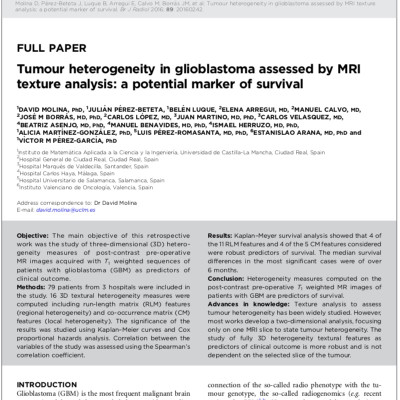Publication
Tumour heterogeneity in glioblastoma assessed by MRI texture analysis: a potential marker of survival.
D. Molina, J. Pérez-Beteta, B. Luque, E. Arregui, M. Calvo, J. M. Borrás, C. López, J. Martino, C. Velasquez, B. Asenjo, M. Benavides, I. Herruzo, A. Martínez-González, E. Arana. L. Pérez, V. M. Pérez-García
British Journal on Radiology 89, 2016242 (2016)
MOLAB authors
Abstract
Objectives: The main objective of this work is the study of heterogeneity measures of postcontrast pretreatment magnetic resonance images (MRI) T1 sequences of glioblastoma (GBM) patients as predictors of clinical outcome.
Methods: 79 patients from three hospitals were included in the study. A set of 16 3D textural heterogeneity measures was computed including: run-length matrices (RLM) features (regional heterogeneity) and co-ocurrence matrices (CM) features (local heterogeneity). The significance of the results was studied using Kaplan-Meier curves and Cox proportional hazards analysis. The correlation between the variables of the study was assessed using the Spearman correlation coefficient.
Results: Kaplan-Meyer survival analysis showed that 4 of the 11 RLM features and 4 of the 5 CM features considered are robust predictors of survival. The median survival differences in the most significant cases were of over 6 months.
Conclusion: Many heterogeneity measures computed on the postcontrast pretreatment T1 MRIs are strongly correlated with patient’s survival in glioblastoma.















